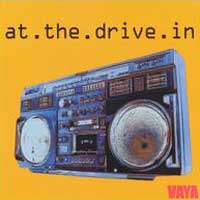
At The Drive-In
Vaya (1999)
thricedoesntequalgod
Pulsating bass; Slow latin-sounding drums; a quaint echoing guitar; a clapping sound; pause; Cedric Bixler's voice. At the Drive-In is present in the air.
Rascuache is a prime example of ATD-I's sound. A verse which goes back and fourth between a slower and intense 2 1/2 seconds. A sped up chorus that leaves your heart pounding. Repeat. One of ATDI's strange guitar leads comes in, followed by an echoed voice that gives you a mental image of Cedric himself, viewed through a cracked mirror.
A double-bass beat opens the song. Cue Bass. "T-Minus, 10 seconds and counting, 10 seconds to go". These are the half-muffled words that you will find yourself trying to repeat after spoken. A country-sounding guitar comes in, pushing you slowly to the edge as it builds up. Then rocks in the chorus that falls somewhere in between In/Casino/Out and Relationship of Command on the ATDI scale. If you listen closely, past the production, you can hear a cool guitar riff in the midst of the strumming guitar. Somehow, the production on the guitars works, with its thick, choppy sound.
Ursa Minor is more reminiscent of Mars Volta, and to some degree you can really hear the influences peeking out like sunshine on a cloudy day. A strange strumming jumps back from right to left, playing with your ears, and a static-induced bass leads us home. "So I guess this is goodnight.." is whispered into our ears, but it isn't the end of the night for the song. Dual vocals are prominent throughout the song and a rarely used (by ATDI) palm mute is used during the slower part of the song
Keliotrope decides to speed things up, from the bat. A high-pitched lead guitar is consistent throughout the whole song, proving to be one of the main focuses in the song (the other being vocals). In the final chorus, a cool drum beat or two is shown off and the rythm guitar is noticably turned down, giving the two focuses more power.
For track 5, Metronome Arthritus, we refer back to Ursa Minor's Mars Volta reference. This down-tempo tune starts off with static, among other things, and then jumps to Bixler (version 2003) for a little while. Static rejoins the verse and soon after, a bass/lead guitar duo gets added to the mix, undistorted. The chorus is repeated for one last time, and you can tell that the song has been building up throughout, to reveal even more emotion this time around.
300 MHz starts off with a very space-like feel to it, maybe some of that much talked about Rage Against the Machine bass influence. Towards the middle of the song, you hear heavy breathing and whispering, giving the song a dramatic tone.
198d starts off with a very space-like feel. A slow beeping noise catches your attention by being unique to the album. A soft riff is repeated accompanied by soft vocals. The volume is raised a notch or 6 for the chorus, spitting emotion in your face.
After being repeated twice, a small piano/bass/guitar part is played, and what might've also made a nice closing to the album turns into a heartfelt, catchy, minute-long ending.
Seen by many, including myself, as ATDI's best album, I believe this is an example of their most concentrated work. If these seven songs were part of a full album, it would probably be their most widely favored collection of songs. I'll take it as-is.